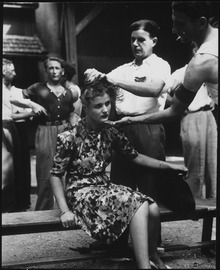Horizontal collaboration

Horizontal collaboration (French: Collaboration horizontale, collaboration féminine or collaboration sentimentale) referred to the romantic or sexual relationship many French women had, or were alleged to have had, with members of the German occupation forces after the fall of France in 1940. The existence of these liaisons had been a major reason for young men to join the French resistance.[1] With the liberation of France from German occupation, these women were often punished for collaboration with the German occupiers.
After the war, throughout France, women accused of collaboration had their heads shaved.[2] In many of the ca. 20,000 cases, the women in question had only performed professional services for the occupying Germans, rather than being engaged in sexual relationships with them.[3] Due to the head-shaving in public spaces being used to punish women thought to be collaborators, and the presence of many foreign photographers in post-war France, thousands of photos exist of women being subjected to this punishment.[4]
"Collaboration horizontale" is believed to have produced 200,000 French babies with German fathers.[5] Since 2009 Germany has offered these children of "the other bank of the Rhine" citizenship, after French foreign minister Bernard Kouchner lobbied for their recognition.[6]
Depictions in film
In Hiroshima mon amour (1959), the female protagonist is revealed to have been shaven as punishment for collaboration horizontale as a result of her relationship with a German soldier.[7] The film visually linked the suffering of women forcibly shaved after D-Day with the loss of hair experienced by survivors of Hiroshima and Nagasaki. [8] The phenomenon also inspired the 2010 film Collaboration horizontale, a documentary exploring what happened to the baby shown in the photo of The Shaved Woman of Chartres.[9] In the 2000 film Malèna a woman in wartime Sicily is punished for her beauty and for liaisons with German soldiers by the local women ripping off her clothes, beating her and shaving her hair.[citation needed]
In popular media
- The 2019 graphic novel Horizontal Collaboration tells the story of a liaison between a French woman and a German soldier in wartime France.[10]
See also
- The Shaved Woman of Chartres (1944 photograph)
References
- ^ Crowdy, Terry (2007). French Resistance Fighter: France's Secret Army (PDF). Oxford: Osprey Publishing. p. 8. ISBN 978-1-84603-076-5.
- ^ Fabrice Virgili (1995). "Les "tondues" à la Libération :le corps des femmes, enjeu d'une réaproppriation". Clio. Femmes, Genre, Histoire.
- ^ Marc Bergère (September 2004). "Tous les milieux sociaux ont été visés". Historia (693). Paris: 56–60.
- ^ Alison Moore, History, Memory and Trauma in Photography of the Tondues: visuality of the Vichy past through the silent image of women. Gender and History 17 (3), November 2005, 657-681.
- ^ Shapin, Stephen (20 September 2013). "Book Review: 'Brave Genius' by Sean B. Carroll". Wall Street Journal.
- ^ "Les "enfants de la guerre" reconnus par Berlin". Libération. 20 February 2009.
- ^ Carmen M. Cusack (3 November 2015). HAIR AND JUSTICE: Sociolegal Significance of Hair in Criminal Justice, Constitutional Law, and Public Policy. Charles C Thomas Publisher. pp. 64–. ISBN 978-0-398-09096-8.
- ^ Amal Amireh; Lisa Suhair Majaj (1 May 2014). Going Global: The Transnational Reception of Third World Women Writers. Routledge. pp. 298–. ISBN 978-1-317-95409-5.
- ^ "Collaboration horizontale". IMDB.
